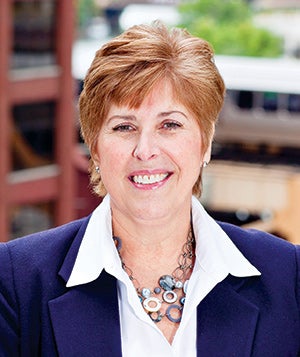Working for a safer, healthier care environment
Association for the Healthcare Environment (AHE) Executive Director Patti Costello and AHE Advisory Council members assess progress and challenges for those who clean and maintain inpatient and outpatient care facilities.
What key challenges face ES professionals today?
The volume of priorities associated with reaching the top of your respective organization’s benchmarking group include:
• Achieving the Quadruple Aim. This covers the Institute for Healthcare Improvement’s Triple Aim of better health for the population, better care for individuals and lower cost through improvement. We’ve added a fourth aim: improved provider satisfaction or improved workforce satisfaction — in essence, preventing worker burnout. This is challenging because, by the nature of the work, striving to achieve the existing aims potentially adds a level of stress to technicians’ daily work.
• Communicating with executive leadership. We must explain the critical role of environmental services to achieve the Quadruple Aim. This particularly applies to infection prevention (lowering cost), care improvement (safety and patient engagement) and increasing patient satisfaction. We need to discuss novel disinfection technologies such as ultraviolet light and explain that it augments rather than replaces the work of technicians.
• Adjusting staffing to meet changing census needs. To be successful, environmental services departments must be able to look at the fluctuating daily census and adjust staffing accordingly. Gone are the days of rigid staffing models based only on square footage or flat staffing models.
• Shifting facility trends. Hospitals are adjusting facility design to manage the shift to outpatient care. Environmental services leaders must be prepared to make this shift quickly to support areas where patients have to be moved efficiently through the care environment. For example, rather than daily cleaning of an occupied patient room as well as discharge cleaning, the demand is for quick, multiple turnarounds of outpatient rooms and, perhaps, at multiple locations.
• Staff training. ES staff must be trained in effective communication, critical thinking and problem-solving to be aware of the revolving census activity, the importance of cost accountability related to consumables and infection prevention.
• Evaluating products. Products must accommodate fast turnaround times. Disinfectants requiring a dwell time greater than a few minutes are impractical.
• Standardizing products and shifting. Waste is generated more quickly in an outpatient setting. Mobility, efficiency (eliminated waste) and speed will drive the successful usage to new products without disrupting operations and behaviors.
What are the AHE’s key priorities this year for educating and advancing members’ skill levels?
Continuous improvement and expansion of AHE’s education portfolio: short term, we are launching two new signature programs; longer term, we will launch new programs yearly.
We are developing a competency road map for the profession at all levels and communicating Phase 2 of the We Are Environmental Services program — encouraging rebranding from “housekeeping” and providing the tools to help departmental leaders make it happen.
Can you explain some of the certification programs AHE has added?
The Certificate of Mastery in Infection Prevention is a great opportunity for long-term professionals wanting to expand their knowledge base in infection prevention to areas like antibiotic resistance, infection prevention during construction and other areas not typically taught in environmental services. It is also for professionals new to environmental services to demonstrate mastery of the fundamentals.
Certified Healthcare Environmental Services Technician, or CHEST, is for our patient-facing staff and ensures that there is a consistent definition of excellence that also can be recognized and rewarded at a national level.
Certified Healthcare Environmental Services Professional, or CHESP, is for environmental services leaders to ensure baseline competency of foundational elements of the profession. The price of admission to be a manager or director of environmental services should be CHESP. The requirements of CHESP demonstrate that a professional has been in the field long enough to apply core skills outside the learning environment and understands the complexities of today’s environment. This fall, we will launch certification for environmental services technicians who care for the surgical environment.
What’s covered in the environmental sustainability certificate program?
This program not only provides guidance on efficient, effective and value-added environmentally sustainable health care operations in a way that is achievable within all budgets. It is part of the AHE’s overall sustainability initiative, which includes ongoing development of sustainability programs, publications and educational opportunities.
How did the CHEST program evolve?
The vision for the program came more than 11 years ago. However, front-line workers are not the core of our membership, so it was critical that we had a portfolio of education and resources for our core before we branched out to their teams. We knew the program would be a success, but it has exceeded every expectation not only for AHE but for the trainers and the technicians being trained.
What skill sets, training and education will environmental services professionals need going forward?
Environmental services must continue to raise the bar for what front-line technicians and leaders need to know. Infection prevention is growing increasingly complicated and environmental services teams must be dialed into the latest information, literature studies and programming to protect patients, residents and other staff members. To be the tip of the sword, professionals need to be the recognized authority in their work and they need to tell their story again and again and again. Not being heard is a function of not being seen nor involved in telling your story.
AHE has long advocated for greater recognition of environmental services professionals. How do you feel about progress in this area?
This work and the membership fuels my passion as a leader. The board, the members and field have shared a vision and mission that has taken time to build on solid ground. As an organization, we are driven harder by the enormous success AHE has achieved through the expanded portfolio of complementary education provided as part of dues as well as the signature certification and certificate programs. Member engagement and loyalty has been extraordinary.



